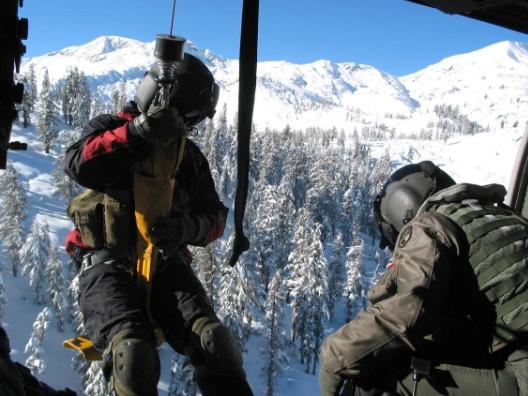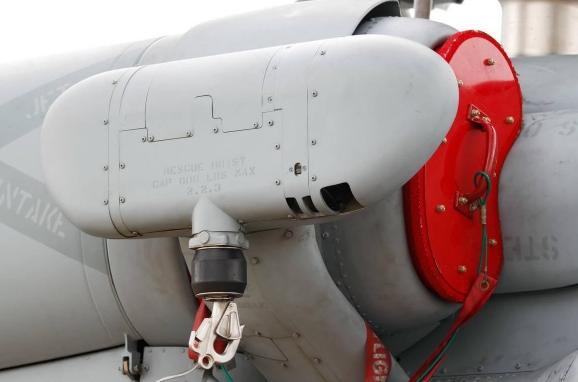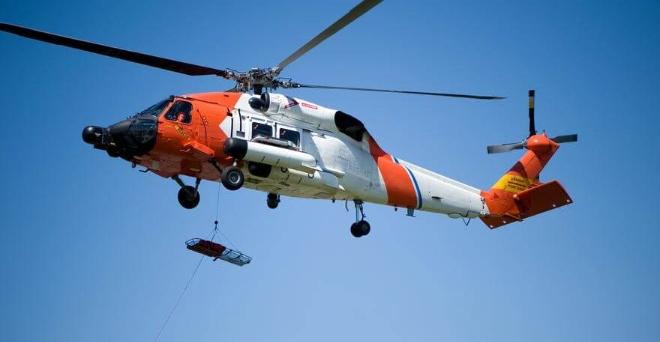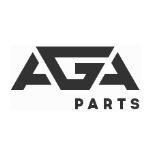Options for SAR Winch Equipment
When it comes to safely transferring a victim into a helicopter, it requires a combination of skills, effort, and specialized equipment, including hooks, lines, and hoists. In this article, we will explore the various options that Search and Rescue (SAR) personnel have at their disposal for this crucial task.
There’s a famous quote attributed to Igor Sikorsky that goes, “If a man is in need of rescue, an airplane can come in and throw flowers on him, and that’s just about all.” The helicopter’s unique advantage as a rescue aircraft lies in its ability to lift casualties from the scene and transport them to safety. To accomplish this, the essential equipment is a rescue hoist equipped with a cable and hook, although a basic capability can be achieved with a fixed line. It’s worth noting that rescue equipment is continually evolving and improving.
Hoists
The design of helicopter rescue hoists has seen continuous improvement since their initial deployment in the 1940s, resulting in increased power and reliability. A typical hoist consists of a hydraulic or electric drive system responsible for winding a cable around a drum, which is accompanied by a braking system.
Collins Aerospace is a relatively recent entrant in the industry, but it inherits a rich legacy of hoist development. The company’s establishment can be traced back to United Technologies (UTC) acquiring Rockwell Collins in November 2018. Some may remember that UTC previously acquired Goodrich, a renowned manufacturer of helicopter rescue hoists, in 2012. According to Al Killeffer, Senior Public Relations Manager at Collins Aerospace, the company is currently testing prototypes of its fifth-generation hoist, named Pegasus. He stated:
“Pegasus marks our first ground-up hoist design in decades and signifies a significant advancement in hoist technology for the sector.”
Collins Aerospace emphasizes several notable features in its new unit, including an enhanced traction drive, improved cable handling, and the inclusion of a level-wind system to boost reliability. In addition to these mechanical advancements, hoists have also become more user-friendly over time. For instance, the Pegasus comes equipped with digital displays for load and fleet angle, a clutch-slip indicator, and a Health Usage Monitoring System (HUMS) for improved operational monitoring.
Integrating a hoist onto a helicopter is a significant endeavor, often considered a durable investment. However, Collins has taken steps to simplify the upgrading process for owners. Killeffer clarified:
“Pegasus will offer full compatibility with our current hoist footprints, facilitating straightforward installation as a seamless retrofit.”
Jenoptik’s SkyHoist 800 electric winch, to be released under the Vincorion brand, is expected to launch around the same time. The company informed AirMed&Rescue that this new winch will be lighter while offering improved lifting capacity and lower operating and maintenance costs, thanks to its modular design. Back in 2017, Jenoptik emphasized the compact size of this innovative hoist.
As of now, two fully operational SkyHoist 800 prototypes are undergoing rigorous testing to validate their technical performance. Jenoptik’s plan for 2019 involves commencing qualification tests as a step towards achieving certification.

Hoist hooks
While a hoist hook may appear ordinary, its significance within the entire rescue system cannot be overstated. Over the years, substantial progress has been made in enhancing the safety and reliability of hooks, particularly in preventing unintended load release, which could jeopardize both the rescuer and the casualty. The primary concern is not mechanical failure, such as metal fractures, but a phenomenon known as dynamic rollout, also referred to as ring reversal. The US Federal Aviation Administration (FAA) provided a description of dynamic rollout in a 2016 Safety Alert for Operators, stating:
“When the ring in the rescue strap and the hook are temporarily relieved of the load, a dynamic condition exists allowing the ring to travel up and flip over the tip of the hook and come to rest on the spring-loaded keeper. The ring is now only supported by the spring-loaded keeper. When the load is re-applied, the ring is forced open, and the spring-loaded keeper allows the ring to fall free from the hook, thereby inadvertently releasing the occupant or load.”
Dynamic rollout has tragically contributed to fatal accidents, prompting the FAA to recommend the use of rescue hooks equipped with mechanical locking keepers or guards to prevent D-ring reversal.
Dynamic rollout is not just a theoretical concern; it has tragically been responsible for several fatal accidents. As a response to this serious issue, the FAA strongly recommends that flight crews exclusively utilize rescue hooks equipped with mechanical locking keepers or guards to effectively prevent D-ring reversal.
Locking mechanisms have been a significant focus of innovation for hook manufacturers. According to Lifesaving Systems, a US-based company, they have observed a notable shift in the past two decades. They initially introduced hooks with locking gates. Today, it’s become more common to witness multiple loads being connected to a single hook, such as rescuers, stretchers, tag lines, and medical equipment, all being hoisted simultaneously. Predicting the various attachment rings that users might employ on a hook has become a greater challenge for manufacturers.
The company embarked on a redesign of its D-Lok Hoist Hook upon discovering a specific attachment ring, the SETS Ring, which could potentially disengage (though it requires precise manipulation, according to the company). Lifesaving Systems’ General Manager, Mario Vittone, informed AirMed&Rescue that the company will be launching the newly redesigned D-Lok Hoist Hook this year. The updated hook incorporates a double-locking gate. Regarding the prototype, the company stated:
“We conducted extensive testing on the design, considering every conceivable ring. Every possible measure has been taken to prevent unintentional activation of the latches, short of permanently sealing the gate. The new gate design (patent pending) provides full protection for the latches from all angles, ensuring that no straight or curved metal ring or any length of webbing or rope can trigger an auto-locking gate latch. The gate will always remain double-locked, regardless of the type of ring used on the hook.”
The real test will be to determine whether the hook lives up to Lifesaving Systems’ claims of ease of use. According to the company, the gate can still be operated with one hand, which is a crucial necessity in time-sensitive missions and challenging environments like open sea rescues. Intriguingly, the company mentioned that the new gate can be retrofitted onto existing D-Lok hooks, offering the option of an upgrade rather than a complete replacement.
The HeliBasket Remote Cargo Hook, operated via solenoid, features an integrated swivel and is designed for carrying external loads beneath a helicopter using various length lines. This system allows the helicopter crew to engage, lift, transport, and release external loads in confined areas. Integral Risk Global, the distribution and training partner for HeliBasket, offers electric long lines that support various load types, and their swivels protect the rigging associated with standard, nonstandard, or unique external loads. The Remote Cargo Hook attaches at the lower end of the Electric Long Line strop and can be operated by the pilot or rear crew member. Each hook incorporates an integrated swivel mechanism to prevent load twisting and unnecessary fatigue on the long line. Using the Remote Cargo Hook in conjunction with the Electric Long Line enables the helicopter to attach and release loads while maintaining a high hover, enhancing safety, speed, and efficiency. Rear crew members can operate the Remote Cargo Hook via the Remote Hand Controller, reducing pilot workload. Additionally, ground crew can maneuver the hook to the load, even when the long line is up to 200 feet long, further improving speed and efficiency while keeping the aircraft at a safe altitude to avoid ground obstacles and hazards. Numerous operators worldwide, including the US Army, Tokyo Fire Department’s Hyper Rescue Unit, and Spanish Army SAR units, are currently using both Electric Long Lines and Remote Cargo Hooks.
In night missions, visibility is crucial, especially when dealing with hoist hooks. This is where the DarkLight G2, manufactured by Zephyr International, comes into play. It’s an LED device designed to illuminate the hook assembly, significantly enhancing safety during rescue hoist missions in low-visibility or nighttime conditions. The DarkLight G2 features both green and red LEDs for improved hook visibility and signaling, along with infrared (IR) compatible LEDs for covert operations. Importantly, installing this device doesn’t require airworthiness certification.

The weakest link
Looking ahead, there may be changes on the horizon for the design of breakaway links, also known as weak links. These crucial components ensure that a snared tagline or trail line detaches from the helicopter when a specific force threshold is reached, preventing potentially hazardous entanglements. Adam Davies, Manager SART/TAC at Priority 1 Air Rescue, believes that it’s time to reconsider the design of these breakaway links. He remarked:
“There’s a significant gap between modern best practices and the available devices. The outdated notion of ‘because we’ve always done it that way’ is something we’ve been moving away from in various aspects of helicopter SAR equipment.”
We’ve been gradually departing from the traditional mindset of “because we’ve always done it that way” in many aspects of helicopter SAR equipment, as highlighted by Adam Davies from P1AR.
Despite advancements in various areas of helicopter SAR equipment, there hasn’t been as much innovation in breakaway ‘weak’ links, according to Davies. He noted that their founders, who had experience in ground-based rope rescue and rope access, emphasized the importance of breakaway links that could be manually released by a human rather than solely relying on the helicopter to trigger them.
To align with this approach, P1AR has designed its breakaway links to break at around 100 lbs (45 kg), a force that can be easily managed by a person if required. In contrast, the majority of breakaway links available today adhere to a military standard with high breaking strengths. Davies mentioned that U.S. military branches involved in hoisting typically utilize breakaway links with breaking strengths ranging from 300 to 500 lbs (136 to 227 kg).
The challenge, as Davies sees it, lies in shifting the mindset of organizations by highlighting the potential consequences of line entanglement. He explained:
“Organizations and agencies that resist the idea of using lower capacity breakaway ‘weak’ links often do so due to a general lack of knowledge and awareness of certain emergency procedures. Specifically, the risks associated with the possibility of the aircraft forgetting to release the tagline and flying away (which is a significant concern when operators employ dynamic hoisting techniques) or in the event of an aircraft emergency where the aircraft has to fly away while a tagline is in use.”
Davies suggested that helicopter SAR professionals should discuss scenarios like performing a single hoist extraction of a litter during a power loss emergency. If the ground-based rescue specialist cannot break the weak link, and the aircraft takes off with the tagline trailing, it could potentially pose a threat to the tail rotor. He emphasized that through discussion and experimentation with different breakaway ‘weak’ links in a safe and controlled training setting, many agencies might become more open to changing their approach to address these potential issues.
In situations where the hoist cable becomes entangled in ship rigging, trees, rocks, railings, or poses a danger around the rescuer’s neck, a swift cable cutting solution is essential. Zephyr International has introduced its AxelCut product to address this critical need for a safe and rapid cable cutting method. Unlike the existing two-handed cable cutters, which are often slow and ineffective for this purpose, AxelCut is designed to offer speed and safety. The product is also designed to remain unaffected by electromagnetic interference (EMI), lightning, or other potential hoist system failures, all while maintaining low cost and long-term durability, according to the company.


